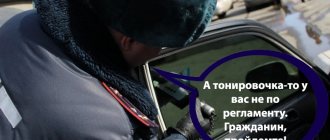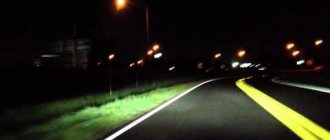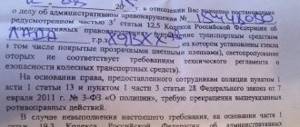Is it possible to remove tint and avoid a fine in 2021?
According to the requirements of the law, the driver is obliged to comply with the legal requirements of the inspector - Part 3 of Article 30 of the Police Law. These are the requirements associated with the collection of evidence in an administrative case. If there are visual signs of a violation (dark glass), then the inspector has the right to demand measurement of their light transmission. Obstruction of measurements - failure to comply with legal requirements with subsequent punishment under Part 1 of Article 19.3 of the Code of Administrative Offenses, up to arrest for 15 days.
Let's trace the chain of legislative acts at the request of the inspector!
- Legal are the demands of traffic police officers that are based not only on their rights and responsibilities, but for which the procedure for exercising rights and responsibilities is determined - part 3 of article 12 and part 3 of article 13 of the Federal Law on Police.
- This procedure is given in paragraph 126 of the regulations, which contains references to paragraphs. 96-99 of the Administrative Regulations for Supervision of the Technical Condition of Vehicles.
- In addition, restriction of the rights and freedoms of citizens is permissible only on the grounds and in the manner established by federal law - Part 2 of Article 6 of the Law “On the Police”.
- The grounds are specified in paragraph 111 of the Administrative Regulations of the State Traffic Safety Inspectorate. We are talking about the presence of signs of an offense under Article 12.5 of the Code of Administrative Offences.
- According to the listed standards, the inspector’s demands to provide a car to measure light transmission are considered legal. And, if the driver, instead of fulfilling a legal requirement, rips off the film, then he is sent to a judge, who makes a decision on punishment under Part 1 of Article 19.3 of the Code of Administrative Offenses.
According to the listed standards, the inspector’s demands to provide a vehicle for measuring light transmission are legal. And, if the driver, instead of fulfilling a legal requirement, rips off the film, then he is quite rightly sent to a judge, who makes a decision on punishment under Part 1 of Article 19.3 of the Code of Administrative Offenses. True, not every removal of film will result in punishment.
Will I be fined if I remove the tint?
As mentioned above, not only a fine is issued for tinting, but also an order to remove it. This order is registered in the traffic police database, and if 10 days after this, inspectors catch a driver with the same tint, then the punishment will be imposed under Art. 19.3.
If you remove the tint on the spot, the driver will only avoid the prescription. The offense has already been committed, which means the inspector has every right to fine the motorist under Art. 12.5. At the same time, the inspector is not required to prove that the car was tinted. All he needs is a visual recording of the violation, therefore, removable tinting will not protect the driver from a fine, even if he manages to remove it before the inspector approaches the car.
When is it not necessary to remove film at all?
Requirements for the light transmittance of rear windows, relevant for 2021, are established in clause 4.3 of the Technical Regulations “On the Safety of Wheeled Vehicles”. And the rear windows can be covered with film without any restrictions. The only requirement is the presence of side rear view mirrors on the right and left.
Front windows must have a light transmittance of 75%, as specified in UN Regulation No. 43. Otherwise means making changes to the design, with subsequent possible termination of vehicle registration. However, in the mentioned paragraph 4.3 of the regulations, a reduction in light transmission of up to 70% is allowed, apparently due to the natural wear of the glass.
If you plan to use the car as a living room in case you are kicked out of the house, and it is constantly parked and does not go on the road, then you can paint over all the windows with black paint. The percentage of light transmission is important only when driving a car, which begins the moment it starts moving.
Thus, tinting is not prohibited in principle, but there are 2 conditions:
- or your car is stationary, and then you can at least board up all the windows with plywood,
- you drive a car, then the tinting together with the glass must transmit at least 70% of the light, otherwise such film must be torn off by law.
You will also be interested in:
- Who is responsible for the car if the driver is picked up by traffic police officers and taken away?
- All about the new warning in the police in questions and answers
- Does a traffic police officer have the right to stop and check the documents of pedestrians and passengers?
Legal tinting standards
Every driver must know his or her rights in order to be able to defend them if stopped by an inspector. According to the technical regulations “On the safety of wheeled vehicles,” the driver has the right to tint the rear windows without restrictions on the degree of light transmittance. Inspectors do not have the right to take measurements of this area of the car or require film removal.
According to the same regulations, the light transmittance level of the front windows should not be less than 70%. This standard is established for driver safety. With less traffic capacity, a person will not be able to monitor the situation on the road, which will lead to accidents and disastrous consequences.
Also, tinting on the top of the windshield is not considered a violation. A strip 14 cm high is allowed there, which can run from edge to edge of the glass and have any level of light transmittance. If this strip is wider than 14 cm, the offender will also be punished.
We removed the tint before measuring - what happens?
Let's return to our case when the driver removed the tint before measuring its dose of transmitted light. As already mentioned, this threatens the driver with a fine or arrest for up to 15 days under Part 1 of Article 19.3 of the Administrative Code. But everything is not as simple as it seems to police and judges.
As stated, in order to limit the rights and freedoms of a citizen, the federal law must specify the procedure for restriction. For the Code of Administrative Offences, this is Section IV of the Code.
For example, according to the Code of Administrative Offences, to establish the event of driving a vehicle while intoxicated, a protocol of removal from driving a vehicle, an examination report, a protocol of referral for a medical examination are drawn up, and certified by witnesses.
There is nothing similar in the Code of Administrative Offenses to establish the event of an offense related to the technical condition of the car, including those related to tinting.
To be fair, there is no point in focusing particular attention on a trivial omission in the legislation, since all traffic police vehicles are equipped with devices for measuring light transmission, and the loss of drivers’ time on measurements is minimal.
But the situation changes when the device turns out to be faulty or the inspector does not have the device with him. The traffic police officer leaves to look for the device, at the same time smoke, eat, chat, make a call, breathe... And the driver is ordered to wait and not rock the boat. This action in the Code of Administrative Offenses is called detention, which is properly formalized. No registration – the detention is illegal.
Against the background of an illegal detention, the lack of order defined by federal law when measuring light transmission takes on a completely different shade, emphasizing the ignorance of the inspector - one can still agree with a slight violation of the law, but lawlessness is already too much.
Brief information: detention is legal when it takes place:
- base,
- target
- and the motive for the arrest.
If the inspector goes to look for the device, then the motive for the arrest is replaced by the goal - collecting evidence of an offense, which once again proves the incompetence of the policeman. But this is a topic for another article.
If the detention is illegal, then all subsequent actions of the inspector are also illegal. Therefore, removing tinting cannot in any way contradict the requirements of the law. Moreover, if the driver manages to remove the tinting from all windows.
Can you imagine how long it takes to remove film from all glass by an untrained person without any tools? And where was the inspector at that time?! But according to the standards, only 30 minutes are allotted for a complete technical inspection of a passenger car on the road, including measuring the light transmittance of the windows - clause 99 of the regulations on the supervision of the technical condition of vehicles.
By the way, you can read about the measurement rules in our special article.
Can a traffic police officer seize the film and rummage through the car?
All reasons for searching a car are listed in paragraph 202 of the regulations, which fully complies with the requirements of the Code of Administrative Offenses and the Law on the Police. The torn film is neither an object nor an instrument of a crime, just as it is neither a drug nor ammunition. The same applies to the inspection of things in the possession of an individual.
Therefore, the inspector has no right to seize the film and rummage through the driver’s belongings.
Can an inspector detain or arrest?
Arrest is a type of punishment that can only be imposed by a judge. If the driver faces arrest under Part 1 of Article 19.3 of the Code of Administrative Offenses for disobeying the legal demands of the inspector, then the latter has the right to detain him and take him to the magistrate’s court, if the court is open at that moment.
If it is evening or night, then the inspector must have a motive to detain the driver. In order for a person who has a permanent place of residence and who has never hid from any authorities to be shoved into a “monkey box” before trial, the policeman must have an ironclad motive, clearly and clearly stated in the arrest report.
The driver should immediately declare that he is ready to appear in the magistrate’s court at the first request. At the same time, give the exact address of residence, actual place of work, personal telephone number and telephone number at the place of work. This step will confirm that the driver does not intend to hide from justice.
Thus, the arrest is illegal if you removed the tint before the measurement, and there should not be such a penalty for this under the law.
Legal basis
So, if you have tinted front hemisphere of glass with a light transmittance of less than 70%, then you may be issued one of two papers:
- requirement to eliminate tinting as an offense,
- order to remove tint.
Both of these documents are equivalent by law for 2021, have the same force, are aimed at the same goal and will lead to the same consequences, so in the article we will use them as synonyms.
The legislative basis for issuing such orders is as many as 5 legal acts:
- traffic rules,
- Technical Regulations of the Customs Union “On the safety of wheeled vehicles”,
- Code of Administrative Offences,
- Federal Law “On Police”,
- Administrative regulations introduced by Order No. 664 of the Ministry of Internal Affairs.
In more detail, let's list excerpts from each of these legislative acts!
The Traffic Regulations directly prohibit tinting a car in its List of faults and conditions under which the operation of cars is prohibited:
It is allowed to use tinted glass (except for mirror glass), the light transmission of which complies with GOST 5727-88.
As you can see, the traffic rules refer to GOST. But the latter is not relevant for 2019 and is presented as an alternative in the form of Technical Regulations, which precisely regulate the compliance of tinting:
4.3. The light transmission of the windshield and windows through which forward visibility is provided to the driver must be at least 70%.
The Administrative Code, in turn, establishes liability for violations of traffic rules, referring to the Technical Regulations, and prescribes a fine of 500 rubles for tinting:
3.1. Driving a vehicle with glass (including glass covered with transparent colored films) whose light transmission does not meet the requirements of the technical regulations on the safety of wheeled vehicles is subject to an administrative fine of five hundred rubles.
Also, it is in the Code of Administrative Offenses that there is punishment for failure to comply with the legal requirements of a police officer, who is a traffic police inspector:
1. Disobedience to a lawful request of a police officer. shall entail the imposition of an administrative fine in the amount of five hundred to one thousand rubles or administrative arrest for a term of up to fifteen days.
The Federal Law on the Police in its article No. 13 says the following:
1. To fulfill their duties, the police are granted the following rights:
- demand from citizens and officials the cessation of illegal actions, as well as actions that impede the legitimate activities of state and municipal bodies.
And finally, the Administrative Regulations, paragraph 6, prescribes traffic police officers the right to:
6. When exercising federal state supervision, officials have the right: 6.1. Demand that citizens and officials stop illegal actions.
At first glance, based on the essence of the presentation of legal acts, it seems that everything is logical - tinting is a violation of traffic rules, the police are given the right to demand that this violation be stopped, and the Code of Administrative Offenses prescribes the arrest of drivers for failure to comply with the requirement. But that's not entirely true!
Is it possible to rip off and avoid the requirement?
If the light transmission of the glass does not meet the requirements of the Technical Regulations, then the event of an offense under Part 3.1 of Article 12.5 of the Code of Administrative Offenses is established, and either a protocol is drawn up against the driver or an order is immediately issued.
But the policeman has a question: should a driver with tinted windows be released? After all, he will continue to violate the requirements of the law, and such management in itself is unsafe.
To commit an offense, there must be reasons and conditions. In our case, the reason is the application of a tint film. But window tinting in itself is not an offense. For an offense to take place, the driver only needs to start driving. Starting to move, that is, driving a car, is a condition for an offense.
To eliminate the conditions of the offense, the driver with tinting is issued a so-called “Demand to eliminate the conditions leading to the offense.” In itself, such a requirement is illegal - it replaces a warning. But the practice of punishing for failure to comply with the requirement to terminate management in the courts has become established.
In order to avoid having to issue such a paper to the driver, most often in practice in 2021 it is enough to remove the tint from the windows yourself on the spot.
Something else useful for you:
- Is it legal for a traffic police inspector to demand that he get out of the car?
- Requirement for tinting: how to remove it and is it legal?
- Suspension from driving a vehicle in questions and answers
What is the penalty for violating standards and removing tinting on the spot?
Each article in the Code of Administrative Offenses provides for its own degree of punishment. It all depends on the circumstances under which the order or fine was issued. In a standard situation, when a traffic police inspector stops a driver and immediately takes a measurement, the following liability applies: Part 3.1 of Art. 12.5 of the Administrative Code provides for a fine of 500 rubles.
Additionally, the driver is issued an order obliging him to remove the tint within 10 days. If during this time it has not been removed and the level of light transmittance has not changed, then the driver may be held administratively liable under Article 19.3. The punishment is a fine of 500 to 1000 rubles or administrative arrest for 15 days from the date of detention.
If the driver decides to remove the tint film before the inspector measures the degree of light transmittance, the outcome may be different. It all depends on the circumstances. If the traffic police officer has already drawn up a protocol, then no amount of deletion will help. This may only relieve the driver of the order, but a fine will still be imposed.
If they did not have time to draw up a report, and the citizen managed to remove the film from the front windows, then the inspector will have to force the driver to return the film on the spot, since the offense was already recorded visually. The inspector will also have the right to conduct an inspection of the vehicle in order to detect the means of committing an offense.
The policeman demands to eliminate it in front of him - do I have an obligation?
Drivers have a responsibility to comply with legal requirements. These are not only traffic rules, but also the requirements of the Technical Regulations, which set standards for the light transmission of glass.
The driver's reaction time ranges from 0.3 to 1.8 seconds depending on the situation, the driver's condition and other factors. In the dark on unlit roads, the reaction time increases by 0.6-0.7 seconds. For this reason, driving at a speed of 90 km/h at night with low beam headlights is unsafe.
Tinting with light transmission less than 35% increases reaction time by 0.1-0.7 seconds. That is, it is already unsafe to drive a tinted car at high speeds during the day. Driving a tinted car at night is borderline suicidal.
For some time, the driver is saved by excellent knowledge of the road, which reduces reaction time. But one day an unfamiliar object appears in the headlights, its outlines fall on the retina of the eyes, the information goes to the brain, and it begins to recognize. After all, he first needs to decide: is there a danger or not?
The brain solves the problem, time passes, and the driver drives towards an obstacle with the instinct of self-preservation completely turned off.
This is the situation that the requirements of technical regulations prevent. And if a policeman demands that the tint be removed on the spot, then it is better to meet him halfway.
However, there is an alternative option. Driving ends when the need to move is exhausted. This situation occurs if the driver calls a tow truck.
Why are the demands illegal?
Examples of such requirements:
There are as many as 2 contradictions to the law in force for 2021 of such requirements for tinting.
You will complete the requirement within its time limit many times!
The first is to control the vehicle. Above, in the quotation from the traffic rules, it was not for nothing that we pointed out that this is an excerpt from the list of conditions under which the operation of cars is prohibited. The Code of Administrative Offenses also punishes management.
The subtlety is that most often you are issued a “demand to cease the offense.” Meanwhile, as we mentioned above, tinting is permitted and is not an offense. It is a traffic violation to drive with tinted windows with a light transmittance of less than 70%. Accordingly, each start of movement after a stop forms a new composition for this violation.
But at the moment when the request for elimination is issued, the tinted car has already been stopped by a traffic police officer - that is, the offense has been stopped! And, given the average time frame for such orders is 10 days or more, you will stop more than once and essentially fulfill this requirement. You will do it several times a day!
It’s another matter if the ill-fated paper says “Demand to terminate the conditions leading to the violation.” Here the inspector seems to be aware that the violation is the control, and therefore issues a more specific requirement - to stop the conditions that entail the violation, that is, it comes directly from the traffic rules (the list of conditions under which operation is prohibited).
In this case, there is also nothing legal. Tinting is not a condition leading to a violation. Following this logic, one could:
- prohibit the sale of too dark tint film as a condition leading to traffic violations,
- introduce prohibition in the country, given that any drunk citizen of such a country can get behind the wheel.
However, there is still some logic here - after all, the only purpose of a car is its operation and control. And excessive tinting of the front hemisphere will inevitably lead to an offense. Otherwise, why tint the windows if the car will be parked?! However, demanding that the terms of the offense be terminated is still illegal, and here’s why!
There is no regulation for issuing written demands
Law in Russia is based on the clear letter of the law. Otherwise it can not be! And one of the criteria for such clarity is a direct prescription of the order of execution of various procedures, as well as written documents:
- the protocol is regulated by Article 28.2 of the Code of Administrative Offenses, the resolution with a fine is 29.10,
- the procedure for detention is described in paragraphs 179-188 of the Ministry of Internal Affairs regulations,
- and many more administrative procedural actions.
Regarding the requirements, you will not find a procedure for writing them out in writing either in the Code of Administrative Offenses, or in the regulations of the Ministry of Internal Affairs, or anywhere else, because we are talking about the immediate cessation of an offense when, for example, a drunken rowdy beats up passers-by, and a police officer has the right (and the obligation) ) not to give him the opportunity to continue doing this, and about other “acute” violations.
The requirement to remove the tint essentially has no basis in any documents regulating the procedure for writing it, and therefore should not be any kind of argumentative argument in court.
Even more absurd is the requirement criterion, such as its term. And the obligation of witnesses, the presence of a signature of the person in respect of whom it was issued, and what data must be entered into this document are also unclear.
However, in practice, requirements for 2021 are issued in almost all regions of Russia.
Arbitrage practice
- Court decision No. 5-507/2016. The driver was brought to justice under Part 1 of Art. 19.3 of the Code of Administrative Offenses with a fine of 500 rubles for failure to comply with an order to remove tinting.
- Court decision No. 5-1109/2017. The driver, after the requirement was issued against him, lost his tone and re-toned it. As a result, the district court vacated the Article 19.3 proceedings for failure to comply.
- Decision of the Krasnodar Territory Court No. 1-66-2011. The driver asked that the demand be declared illegal on the basis that it had already been fulfilled, since the vehicle had already stopped. The court did not satisfy the complaint.
- Court decision No. 5-218/2016. The court dismissed the case on the basis that traffic police inspectors drew up a report on the driver under Article 19.3 on the last day before which the requirement to remove the tint was issued.
Today I have finally prepared for you a publication dedicated to answering the question, is it legal for a traffic police officer to require him to remove tinting on the spot? To be honest, it took me more than a week to prepare this note - perhaps this is the most time-consuming note on the blog, since I had to sift through a bunch of legal information, legislation, and judicial practice on this issue.
In general, the reason for writing this note was questions from readers of my blog regarding the issue of arrest for tinting.
In practice, the following situation occurs. You are driving a car with a tint film that does not comply with GOST on the front side windows (and/or windshield). A traffic police officer stops you, after which, despite all your arguments, he draws up a protocol under Part 3.1 of Art. 12.5 Code of Administrative Offenses of the Russian Federation. The traffic police officer motivates his conclusions about the violation of this paragraph by the fact that tinting is a coating that limits visibility.
After the protocol is issued, the traffic police officer offers the driver to eliminate the violation on the spot, that is, in other words, to remove the film coating from the windows, which limits visibility from the driver’s seat, right in the presence of the inspector. Of course, there is no driver who would want, just like that, “out of the blue,” as they say, to take and rip off the tint, on which he once spent a certain amount of money.
In turn, the traffic cops, with some special pride or something, (judging by the reviews of blog readers), indicate to the driver that if the driver does not comply with their legal requirement to remove the tint on the spot, the driver will face arrest for up to 15 days. Car enthusiasts, of course, don’t understand how it’s possible to get arrested for tinting? They doubt the legality of the traffic cops’ demands to remove the tint coating on the spot, so they rarely agree with the traffic cops, but they will be disappointed in court - the justices of the peace, one after another, stamp decisions in favor of the traffic police, and some motorists have already felt the hard way what a camera for an administrative officer is. - detainees in a temporary detention center.
How to avoid all this? How to determine the legality of the traffic cops' demands in this case? How and what should you say to a traffic cop in such a situation? More on this below in the form of step-by-step instructions, with your permission, my friends.
Attention: Due to changes made to the regulations of the Russian Federation regarding tinting and which came into force on September 23, 2010, the information contained in this note may be out of date.
I’ll immediately make a reservation that this note will help you ruin any administrative case regarding tinting, since our tactics will be to use procedural means and guarantees for the protection of the motorist.
1. So, your tinted car was stopped by a traffic police inspector, satisfied with his own importance and confident in his unshakable rightness. After the traffic police inspector has introduced himself, we ask him about the grounds for stopping your car.
2. The traffic police inspector begins his conversation about your violation of clause 7.3 of the List of faults for which the operation of vehicles is prohibited. In your conversation with the traffic cop, in spite of everything, you adhere to the dialogue that I cited in my note. Is tinting a coating that limits visibility?
3. If you calmly, without unnecessary nerves and complaints with the traffic police officer, carry out such a dialogue, then it is possible (but not a fact, of course) that you will be able to avoid punishment in a non-conflict way.
4. Let’s assume that the traffic police officer sneezed at your arguments (in about 90% of cases, taking into account recent practice). Further actions that most traffic cops take are measuring the light transmittance of the glass. I mentioned what instruments are usually used for this, where and who is allowed to measure the light transmittance of glass in the article Is tinting allowed? Part one.
5. Once again I would like to draw your attention to the fact that measurements should be made only by a traffic police technical supervision officer, and not by an ordinary IDPS. In addition, before drawing up a protocol on an administrative offense, a traffic police officer must draw up a Vehicle Technical Inspection Report (in the form according to Appendix 3 to clause 26.1 of the Rules for State Technical Inspection of Vehicles).
6. Only after this can a traffic police officer draw up a protocol on an administrative offense, and not vice versa.
The protocol on an administrative offense, as judicial practice and my observations show, is the most valuable document from which a car enthusiast can and should squeeze out certain benefits for himself, as they say, to the fullest extent. But this is the topic of my future practical note.
By default, in order to move on, we will assume that the traffic police officer drew up a report on the administrative offense provided for in Part 1 of Article 12.5 (Part 3.1 of Article 12.5) without procedural violations.
7. Further actions of the satisfied traffic police officer consist of his verbal demand addressed to you to remove on site the covering that limits visibility from the driver’s seat. You, of course, refuse to do this. To celebrate, the traffic police officer takes out from his folder with documents a sample Demand for eliminating the circumstances that led to the commission of an administrative offense, fills in the empty columns in it with a pen, after which he hands the specified Demand to you and asks you to sign it. It’s up to you to decide whether or not to take the specified Request from the hands of the traffic cop, to sign the Demand for familiarizing yourself with it (or maybe for receiving it, it’s unclear, by the way). I would have accepted the specified Requirement, but did not sign. In the future, this Requirement will in any case come up during the trial of the case in court.
8. Next, the question arises, is the specified Requirement of the traffic police officer, drawn up in writing, legal and does the motorist need to comply with it? Good question. Glad you asked it.
So, let's figure it out.
If, after receiving the request of a traffic police officer, you remove the tint in his presence, then the inspector will most likely wish you a safe journey (he drew up a protocol under Article 12.5 of the Code of Administrative Offenses of the Russian Federation in any case, therefore, he is not letting you go for nothing). However, you can make fun of the traffic cop and his demand regarding the elimination of the “malfunction” on the spot - with a smile, lower the front side windows to the limit, and then inform the traffic cop that you have eliminated the malfunction. I haven’t tried to do this myself, so I would be very grateful if you write in the comments about the results of such banter.










